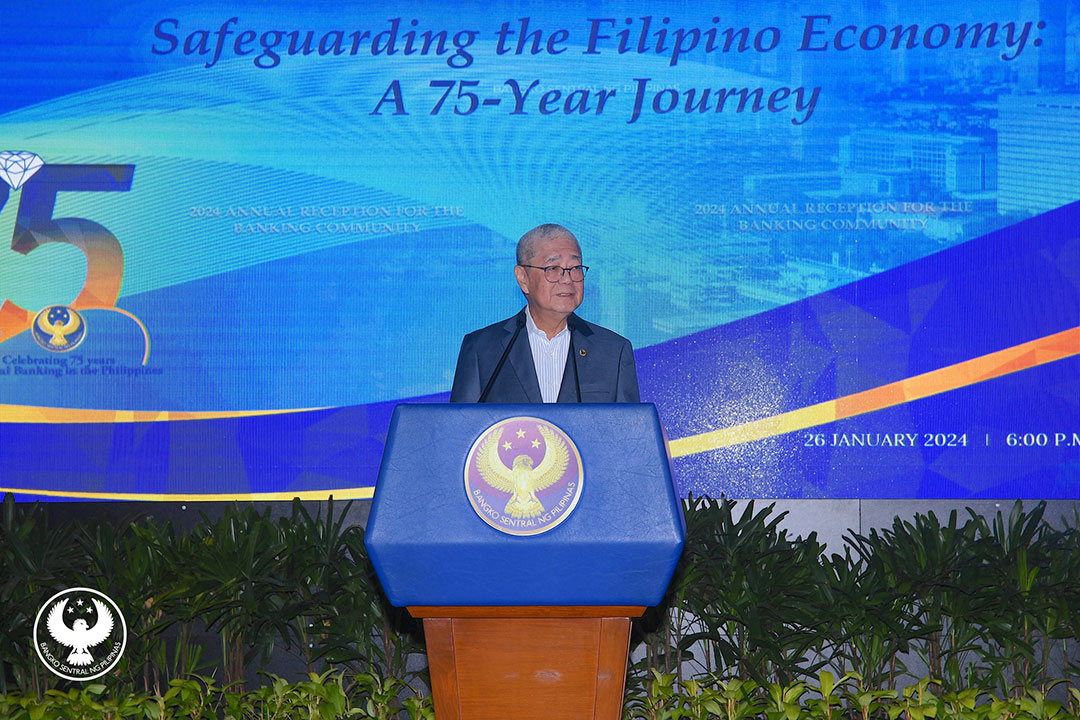




Philippines Trade Update: Trade trajectories trend along
 DOWNLOAD
DOWNLOAD

Policy Rate Updates: Double cut finale
 DOWNLOAD
DOWNLOAD

Monthly Economic Update: One for the road
 DOWNLOAD
DOWNLOAD


BSP says ready to hike rates if Q4 growth remained ‘strong’

The Bangko Sentral ng Pilipinas (BSP) is ready to deliver more policy rate hikes this year if economic growth picked up in the last quarter of 2023, its governor said on Friday.
BSP Governor Eli M. Remolona, Jr. said fourth-quarter gross domestic product (GDP) may be higher than the 5.9% growth in the third quarter.
“If the growth is strong, that gives us a bit more room to hike,” he told reporters on the sidelines of the 2024 Annual Reception for the Banking Community.
Mr. Remolona said the Philippine central bank is still hawkish despite easing inflation and talks about rate cuts this year.
He noted the Philippine economy could still take on further monetary policy tightening by the BSP.
“But the natural rate, we estimate… is very imprecise. Which means, we could hike and it’s still okay, but we’re not sure because it’s an imprecise (estimate),” he said.
However, gross domestic product (GDP) growth may have slowed down in the fourth quarter of 2023, as a BusinessWorld poll of 20 economists yielded a median forecast of 5.7%.
If realized, this would be slower than the 5.9% growth in the third quarter and the 7.1% expansion in the same period in 2022.
The BusinessWorld poll also yielded a median estimate of 5.5% GDP growth for the entire 2023, missing the Development Budget Coordination Committee’s 6-7% full-year target. This is slower than the 7.6% expansion in 2022 and the slowest since the 9.5% contraction in 2020.
The Philippine Statistics Authority (PSA) will release the fourth-quarter and full-year 2023 GDP data on Jan. 31.
Meanwhile, Mr. Remolona said that a rate cut is possible this year amid easing inflation.
“Yes, it’s possible within the year. But maybe the first semester is too soon. We’ll see,” he said in mixed English and Filipino.
He also noted that inflation will continue to be low in January due to base effects, but inflation may still pick up in the second quarter of this year.
Based on PSA data, headline inflation eased to a 22-month low of 3.9% in December from 4.1% in November. It marked the first time that inflation eased within the BSP’s 2-4% target after 20 straight months, from a peak of 8.7% in January 2023.
For the full-year, inflation accelerated to 6% in 2023 from 5.8% in 2022. It breached the 2-4% target band for the second straight year amid soaring food and oil prices.
Finance Secretary Ralph G. Recto said borrowing costs may go down this year in the Philippines and in the United States but “nothing is set in stone.”
“We expect interest rates to go down in the second half, but that will depend on the external environment. So far, the market consensus is inflation and interest rates will go down globally, in the US, and in the Philippines,” he said in mixed English and Filipino.
Mr. Recto said policy rate cuts would not only lower the government’s borrowing costs, but it would also be easier for investments to come into the country.
The newly appointed finance chief took his oath as a member of the Monetary Board last week, representing President Ferdinand R. Marcos, Jr.’s Cabinet at the BSP’s highest policy-making body.
The central bank also said the full impact of the Monetary Board’s aggressive tightening may be felt this year, but authorities are still ready to adjust borrowing costs if necessary.
In an open letter to Mr. Marcos, Mr. Remolona said the BSP paused its tightening in the second half last year due to the slowdown in headline and core inflation.
However, when prices and inflation expectations picked up, the BSP responded with an off-cycle rate hike in October 2023. Since then, the Monetary Board has held fire and kept borrowing costs steady.
“The pause in policy interest rate adjustments has allowed the BSP to further observe and assess how firms and households continue to respond to tighter monetary policy conditions, as lagged effects of prior policy interest rate adjustments are expected to manifest fully in 2024,” he said.
The central bank’s key interest rate currently stands at 6.5%, the highest in 16 years. This was after the BSP emerged as the most aggressive central bank in the region after raising key policy rates by 450 basis points (bps) from May 2022 to October 2023.
Mr. Remolona said inflation may settle within the 2-4% of the government in 2024 and 2025, as shown by the central bank’s baseline forecast. The central bank sees inflation averaging 3.7% this year and 3.2% in 2025.
“However, the balance of risks to the inflation outlook continues to be significantly skewed towards the upside for 2024 and 2025,” he said.
The BSP chief said higher transport fares, increased electricity rates, upticks in oil and food prices due to supply constraints, and the impact of a strong El Niño weather event until the second quarter this year are upside risks to the inflation outlook.
“Should these risks materialize, the BSP’s risk-adjusted forecasts indicate that inflation could settle above target at 4.2% in 2024 before reverting towards the target band at 3.4% in 2025,” he said.
Thus, it is crucial for the government to implement non-monetary measures given the upside risks to food and transport prices, Mr. Remolona said.
“On the part of the BSP, we stand ready to adjust monetary policy settings as necessary to mitigate second-round effects and better anchor inflation expectations, as we continue to prioritize safeguarding price stability in line with our primary mandate,” he added.
The BSP will hold its first policy meeting this year on Feb. 15. — By Keisha B. Ta-asan, Reporter
This article originally appeared on bworldonline.com





 By BusinessWorld
By BusinessWorld